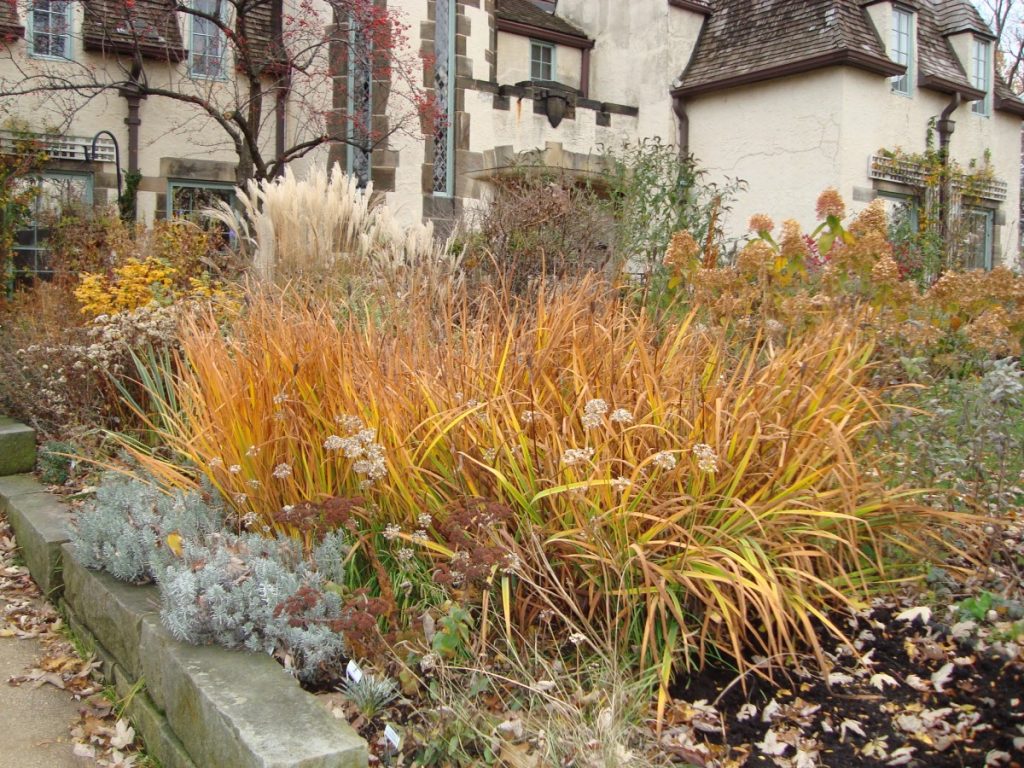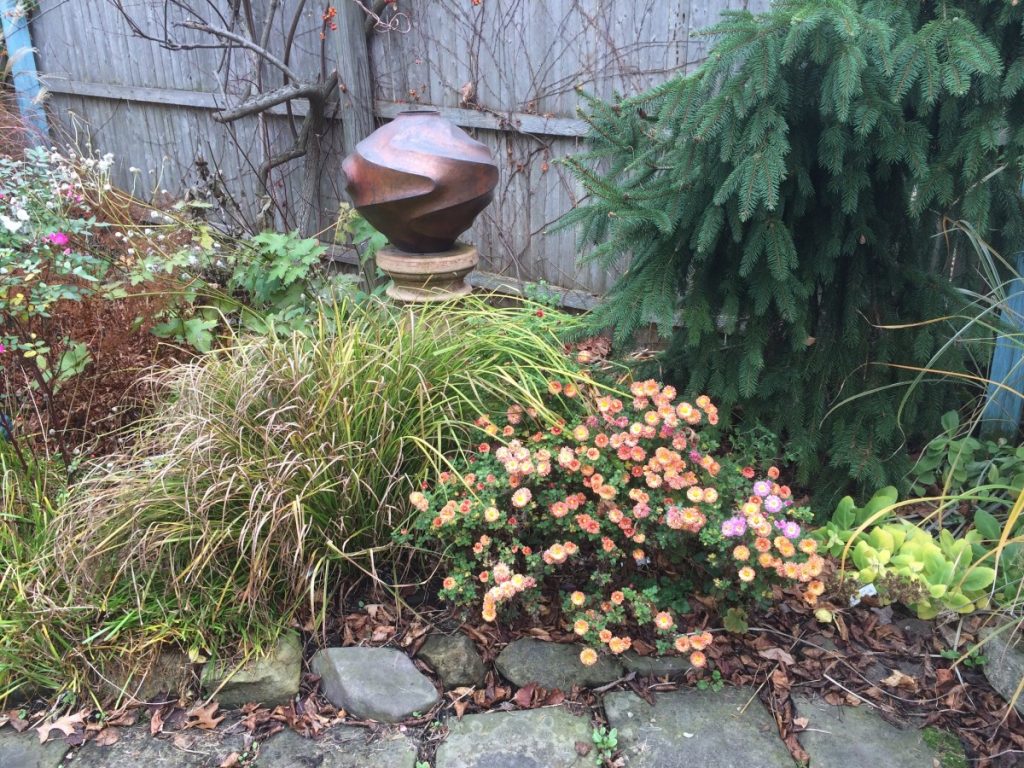

It’s now late September and the garden is still glorious. Late perennials as well as reblooming perennials are at their best. By the time October and November arrive, many people will have given up on their gardens when there is actually more to come. The air is crisp, sunny days are interspersed with rainy ones (finally) and Indian Summer will come and go. The fall perennial garden, although not lush like the summer garden, is still a thing of beauty, particularly if shrub roses, subshrubs, vines and woody ornamentals that berry have been incorporated. There is an extensive range of plants that add color, structure and interest to the fall garden. Giving attention to the fall season in our designs will provide an uplifting and exciting landscape. Let’s discuss some exceptional plants that should be part of it.
The list of fall-blooming perennials is quite long: among these are Aconitum (Monkshood), Anemone japonica (Japanese Anemone), Boltonia (Bolton’s Aster), Eupatorium fistulosum (Joe Pye Weed), Sedum, and Tricyrtis (Japanese Toad Lily).
Other perennials for the fall garden are Asters, Allium tuberosum (Garlic Chives), Eupatorium rugosum ‘Chocolate’, hardy geraniums like ‘Dilys’ and ‘Rozanne’, Physostegia virginiana (Obedient Plant) and the very late blooming but extremely hardy Chrysanthemums such as Dendrathema ‘Sheffield Pink’ and ‘Mei-Kyo’.

I’m sure that many of you are familiar with the New England Asters such as Aster novae-angliae ‘Hella Lacy’ (purple) and ‘Alma Potschke’ (hot pink) but they can grow quite tall unless you cut them back in June but there are some shorter cultivars such as ‘Purple Dome’ and ‘Vibrant Dome’. Be aware that these asters are rhizomatous so give them plenty of space unless you are prepared to dig some up each year. Most asters require full sun.

Eupatorium rugosum ‘Chocolate’ (Chocolate Snakeroot) usually doesn’t start blooming until late September or early October. It has fuzzy white flowers on three to four feet stalks and is distinguished earlier in the year by its dark stems and foliage. Give it full sun or partial shade but be aware that the foliage will be greener in the sun.

I love Allium tuberosum except for its prolific seeding. This can be avoided, however, by assiduous deadheading at the expense of the beauty of the heads during the winter. These Garlic Chives have the typical grassy foliage of alliums but do not bloom until early September and carry their blooms into mid-October. By November, the seedheads begin to lend interest to the garden. Like other Allium, give this one full sun.


Most hardy Geraniums bloom in the spring and early summer but Geranium ‘Dilys’ starts blooming in mid-summer and doesn’t quit until frost. Its small magenta blossoms on loosely weaving stems are quite welcome in October and November. This is a plant to use at the front of the sunny border, either by itself or in between a low clumping perennial such as Allium ‘Summer Beauty’ or ‘Millenium’ or one of the Heuchera. Geranium ‘Rozanne’ and ‘Azure Rush’ (hard to distinguish between them) also start blooming in mid-summer but the flowers are larger and are on taller stems, twelve to eighteen inches instead of eight inches. They, too, will bloom until late in the fall.

I rarely plant chrysanthemums because few of them seem to be hardy. However, there are a few very old cultivars which are reliably hardy. Dendrathema ‘Sheffield Pink’ has pink buds but peachy-apricot blossoms which do not even begin blooming until late September/early October. In full sun, it will grow two feet tall and wide. It is quite lovely and a favorite of mine. I’ve also had Dendrathema ‘Mei Kyo’ (rosy-pink) and ‘Bronze Elegans’ for several years. They bloom a bit later than ‘Sheffield Pink’ and are more of a pompom-type bloom while ‘Sheffield Pink’ is a quill type. If unpinched, they will grow to four feet but if pinched early, will only be eighteen inches.
Most of the ornamental grasses are at their prime in October and November. They vary in height, foliage color and inflorescence color. Miscanthus sinensis (Maiden Grass) can be three to six feet tall with white or rosy feathers; Panicum virgatum (Switch Grass) can be four to six feet tall with pale yellow or rose panicles and the foliage can be blue (yellow after frost) or red. Schizachyrium scoparium (Little Bluestem) and Andropogon gerardii (Big Bluestem) not only bloom in the fall but their foliage becomes bright orange. These are all grasses for sun. For shade, the best fall bloomer is Calamagrostis arundinacea ‘Brachytricha’ (Fall-Blooming Reed Grass) which has dark bottle-brush type inflorescences, at its best when backlit. This grass will be three to four feet tall when in bloom.
Although technically not perennials, subshrubs such as Buddleia davidii(Butterfly Bush), Callicarpa (Beautyberry) and Lespedeza thunbergii (Bush Clover) should be an integral part of the fall garden. The older cultivars of Buddleia grow quite tall but there are now several cultivars that only grow from two to four or five feet tall. They don’t have to be deadheaded to rebloom but their appearance will be improved if they are. Buddleia will begin blooming in mid-summer; Callicarpa actually bloomsin May and June but doesn’t berry until September, and Lespedeza blooms in late August/early September. All will continue to bloom or berry until frost.

There are other options to bring interest into the fall garden. Among them are shrub roses for their low maintenance requirements and their long bloom. The Carpet and Drift series of roses are particularly floriferous as are the Meidilands; their massed color in the fall landscape is particularly vibrant. Some vines, such as the late blooming Clematis tangutica and orientalis, have golden yellow bells in September and October. And don’t forget to use woodies such as Viburnums, Malus (Crabapple) and Crataegus (Hawthorn), to mention a few that have berries in the fall, as background for the perennials and grasses
With all of these suggestions, I know that you can make the fall garden a beautiful and exciting experience.


0 Comments